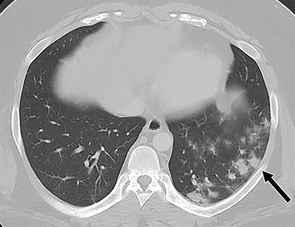Top COVID-19 News of 2020
From imaging guidance to clinical presentations to disinfection procedures, coverage of all the work around COVID-19 this year gave the industry a great deal of insight into the pandemic.
Without question, COVID-19 dominated news coverage this year, and Diagnostic Imaging was no different. Within the hundreds of article published about the virus and its impact on the industry, readers found details about using X-rays, CT, and ultrasound to help detect and manage the disease, information about how the pandemic has impacted imaging volumes, and advice of how to rebound.
But, five articles rose to the top based on audience interest. In the synopses below, refresh your memory on some of the most popular COVID-19 articles of 2020.
1. Abdominal Pain: An Unusual -- But Not Rare -- COVID-19 Presentation
Date Published: April 20, 2020
Early in the pandemic, evidence emerged that abdominal discomfort impacts up to 20 percent of COVID-19 patients. In fact, for 5 percent of patients, it is the only complain. In a study published in the American Journal of Roentgenology, investigators from UChicago Medicine noticed specific abdominal effects in three patients – nausea, diarrhea, and abdominal tenderness. These symptoms prompted abdominal scans that revealed tell-tale pulmonary signs of COVID-19.
Take-Away Message: Radiologists must be aware that COVID-19-positive patients can present with mainly abdominal complaints.
Courtesy: American Journal of Roentgenology

2. CT Severity Scores Can Determine COVID-19 Extent
Date Published: April 2, 2020
A scoring system based on the degree of lung inflammation can help radiologist identify patients with the most severe cases of COVID-19. Researchers from China outlined their three-point system in Radiology: Cardiothoracic Imaging. A “0” score indicates no parenchymal opacification, but a “1” corresponds to less than 50 percent, and “2” indicates more than 50 percent opacification.
Take-Away Message: The scoring system can help providers effectively determine disease burden.
3. Don’t Stop with Disinfecting Surfaces – Clean the Air to Decrease COVID-19
Date Published: Oct. 22, 2020
Protecting imaging professional from the COVID-19 virus takes more than disinfecting machines. Facilities need to create isolated spaces and clean the air, too. In a study published in Ultrasound in Medicine & Biology, investigators from China outlined additional efforts to keep imagers – specifically ultrasound technologists – safe. First, facilities should design specific spaces for patients and providers. Second, they should also put in practices for cleaning the air with both ventilation and ultraviolet light.
Take-Away Message: Rooms should be ventilated before and after patients, and equipment should be cleaned with specific solutions.
4. New Chest Imaging Guidance from the World Health Organization
Date Published: July 31, 2020
The World Health Organization published seven recommendations mid-summer about using chest imaging for diagnosing and managing COVID-19 – three guidelines for diagnosis, four for management. Ultimately, they advocated for chest imaging with diagnosis in symptomatic patients when RT-PCR is unavailable or who have negative results but are still clinically suspicious. With management, chest imaging can be used to determine intensive care unit or hospital admission, as well as change therapy management. Never use chest imaging to determine hospital discharge.
Take-Away Message: These recommendations can be a quick way to determine how acceptable, feasible, and effective chest X-ray, chest CT, and lung ultrasound can be in with patients affected by the COVID-19 pandemic.
5. CT Reveals Differences Between COVID-19 and Influenza Pneumonias
Date Published: July 10, 2020
Artificial intelligence (AI)-assisted software was used to identify inflammatory tissues in lung and automatically segment inflammatory lesions. Three-dimensional image shows regions of COVID-19 pneumonia in lung through AI postprocessing. 57-year-old woman with coronavirus disease (COVID-19) pneumonia and fever for 6 days. Courtesy: American Journal of Roentgenology

COVID-19 pneumonia presents differently from pneumonia caused by the influenza virus. According to research published in the American Journal of Roentgenology, investigators from China determined that COVID-19 lesions are more apt to appear in the peripheral zone close to the pleura. But, lesions from influenza virus pneumonia are more likely to show mucoid impaction and pleural effusion. Other features of the lesions are largely similar across between COVID-19 and influenza virus pneumonia.
Take-Away Message: CT images are not sufficient alone for distinguishing between pneumonia caused by both viruses. The images must be paired with clinical indications.
GE HealthCare Debuts AI-Powered Cardiac CT Device at ACC Conference
April 1st 2025Featuring enhanced low-dose image quality with motion-free images, the Revolution Vibe CT system reportedly facilitates improved diagnostic clarity for patients with conditions ranging from in-stent restenosis to atrial fibrillation.
New Collaboration Offers Promise of Automating Prior Authorizations in Radiology with AI
March 26th 2025In addition to a variety of tools to promote radiology workflow efficiencies, the integration of the Gravity AI tools into the PowerServer RIS platform may reduce time-consuming prior authorizations to minutes for completion.